Abstract
2D layered MXene (Ti3C2Tx) with high conductivity and pseudo-capacitance properties presents great application potential with regard to electrode materials for supercapacitors. However, the self-restacking and agglomeration phenomenon between Ti3C2Tx layers retards ion transfer and limits electrochemical performance improvement. In this study, a 3D porous structure of Ti3C2Tx was obtained by adding alkali to a Ti3C2Tx colloid, which was followed by flocculation. Alkaline-induced flocculation is simple and effective, can be completed within minutes, and provides 3D porous networks. As 3D porous network structures present larger surface areas and more active sites, ions transfer accelerates, which is crucial with regard to the improvement of the superior capacitance and rate performance of electrodes. The sample processed with KOH (K-a-Ti3C2Tx) exhibited a high capacity of approximately 300.2 F g−1 at the current density of 1 A g−1. The capacitance of the samples treated with NaOH and LiOH is low. In addition, annealing is essential to further improve the capacitive performance of Ti3C2Tx. After annealing at 400 °C for 2 h in a vacuum tube furnace, the sample treated with KOH (K-A-Ti3C2Tx) exhibited an excellent specific capacitance of approximately 400.7 F g−1 at a current density of 1 A g−1, which is considerably higher than that of pristine Ti3C2Tx (228.2 F g−1). Furthermore, after 5000 charge–discharge cycles, the capacitance retention rate reached 89%. This result can be attributed to annealing, which can further remove unfavourable surface groups, such as –F or –Cl, and then improve conductivity capacitance and rate performance. This study can provide an effective approach to the preparation of high-performance supercapacitor electrode materials.
1. Introduction
With the increase in environmental problems, the rapid development of new energy equipment, such as electric vehicles, has led to an urgent requirement for energy-storage devices with high-energy density and high cycle stability [1,2]. The key to solving these problems is to construct efficient and safe energy-storage devices to store renewable energy and to obtain productivity effectively [3]. Supercapacitors are electrochemical capacitors, which have a higher capacitance than traditional capacitors as a result of their large-surface-area electrode materials and thin dielectrics [4]. Their unique properties, such as high power density, long life, and environmental protection characteristics, have attracted considerable attention. The electrode material is a key factor for improving supercapacitor performance [5,6]. The thickness of two-dimensional (2D) layered materials, which can reach the multi-atomic or even single-atomic level, is considerably smaller than that of materials with other dimensions. Therefore, these materials exhibit a large specific surface area, high mechanical toughness, and numerous surface active sites. These characteristics render 2D layered materials suitable for electrodes and energy-storage devices [7,8]. The main studied 2D layered electrode materials include graphene [9], metal oxide/hydroxide [10], and transition metal carbide/nitride (MXene) [11,12].
As a novel 2D layered material, MXene has received considerable research attention since its emergence [13,14]. Similar to the 2D structure and surface chemical composition of graphene, it exhibits good conductivity, hydrophilicity, excellent flexibility, and ion intercalation, presenting numerous application prospects for energy storage [15,16]. However, an in-depth study indicated that this material presents many limitations, such as easy agglomeration and stacking; the existence of surface groups substantially influences material properties [17]. The establishment of 3D porous structures is effective to prevent the stacking of MXene, completely use active sites available on the MXene surface, and improve material utilization. Li et al. prepared a 3D Ti3C2Tx aerogel with a unique channel and high specific capacitance of 1012.5 mF cm−2 for the mass loading of 15 mg at a scan rate of 2 mV s−1 in 1 M KOH electrolyte by employing an ethylenediamine-assisted self-assembly process [18]. Shi et al. successfully synthesized a Ti3C2Tx foam having a high capacitance of 122.7 F g−1 through the thermal treatment of Ti3C2Tx films with hydrazine monohydrate in 1 M KOH electrolyte at a scan rate of 5 mV s−1 [19]. Zhang et al. mixed Ti3C2Tx nanoparticles (etched using HF) and Ti3C2Tx nanosheets (etched with LiF and HCl) to acquire a flexible film with an open sandwich structure, showing a high specific capacitance of 372 F g−1 (1 A g−1), which was considerably higher than that of Ti3C2Tx films; after 5000 cycles, its cycle stability was as high as 95% [20]. However, these methods usually require a freeze–drying or filtration process, which limits their application in industrial production.
In recent years, Ti3C2Tx flakes with the mesoporous architecture, which show excellent electrode performance in sodium-ion batteries, have been prepared using the simple acid induced flocculation method of controlling the pH of Ti3C2Tx colloid solutions [21,22]. Dried Ti3C2Tx powders can be obtained using a simple centrifugation and drying process. However, this approach inevitably introduces undesirable –Cl ions onto the Ti3C2Tx surface. Studies have shown that alkalization [23,24] and annealing [25,26] can be performed to remove a part of surface groups and improve MXene electrochemical performance. In this study, we explored the possibility of preparing 3D porous Ti3C2Tx by using the alkaline-induced flocculation method. Furthermore, the alkalization flocculation effects of KOH, NaOH, and LiOH were compared in detail. Simultaneously, the effect of annealing on Ti3C2Tx properties after alkalization was studied. Moreover, the mechanism of alkalization flocculation and Ti3C2Tx surface modification was discussed.
2. Experimental and Procedure
2.1. Materials
Ti3AlC2 powders, used as raw materials, were synthesized through microwave sintering by using 3TiH2/1.2Al/2C mixtures [27]. Sintering temperature and time were 1300 °C and 30 min, respectively. Lithium fluoride (approximately 99.9 wt% pure) was purchased from Aladdin Reagent, Co., Ltd., Shanghai, China. All other chemicals, such as hydrochloric acid (HCl), potassium hydroxide (KOH), sodium hydroxide (NaOH), and lithium hydroxide (LiOH), obtained from Sinopharm Chemical Reagent Co., Ltd., Shanghai, China were of analytical grade.
2.2. Synthesis of Ti3C2Tx MXene
Ti3C2Tx MXene was obtained using the following methods. First, 2 g of LiF was dissolved in 40 mL of 6 M hydrochloric acid. The solution was stirred until the LiF powder was completely dissolved. Then, 2 g of the homemade Ti3AlC2 powder was slowly added to the LiF–HCl etching solution, and the resulting solution was maintained at 50 °C for 24 h under magnetic stirring. The solution was then centrifuged at 3000 rpm for 10 min to separate the powders from the supernatant and washed several times with deionized (DI) water until its pH was higher than six. Afterwards, the resulting Ti3C2Tx powder was added to 200 mL of DI water and ultrasonicated for 2 h in an ice bath and the Ar atmosphere. The resulting solution was centrifuged at 3000 rpm for 1 h. Finally, the dark green supernatant suspension, containing layered Ti3C2Tx flakes with a nominal concentration of approximately 1 mg mL−1, was obtained. We labelled these exfoliation Ti3C2Tx flakes as e-Ti3C2Tx.
To form the 3D porous structure by adjusting the surface functional groups of Ti3C2Tx, a common alkali, KOH, was used as a flocculent. The specific steps of alkalization were as follows: 0.7 g of 1 mol/L KOH was dissolved in 25 mL of e-Ti3C2Tx suspension. The mixed solution was allowed to stand for 30 min to complete alkalization. The supernatant was removed from the alkalization solution, and the remaining product was washed several times with DI water until pH became approximately seven. Then, the solution was centrifuged at 3000 rpm for 10 min to collect the sediments. The obtained sediment was dried at 60 °C for 12 h in a vacuum-drying oven. The alkalization sample treated with KOH is labelled as K-a-Ti3C2Tx. For comparison, two other common alkalis (NaOH and LiOH) were used as flocculants, and their respective alkalization products were named Na-a-Ti3C2Tx and Li-a-Ti3C2Tx. In addition, to improve the state surface functional groups of Ti3C2Tx, after alkalization, M’-a-Ti3C2Tx (M’ represents K, Na, and Li) was annealed at 400 °C for 2 h in a vacuum tube furnace. The annealed samples are labelled as M’-A-Ti3C2Tx (M’ represents K, Na, and Li). The preparation process of 3D porous Ti3C2Tx is shown in Figure 1. To compare the performance between 3D porous M’-a-Ti3C2Tx obtained using alkalization and Ti3C2Tx acquired by employing the traditional pumping and filtration method, a flexible Ti3C2Tx paper (f-Ti3C2Tx) was prepared, according to a method presented in the literature [28,29].

Figure 1.
Preparation of 3D porous Ti3C2Tx.
2.3. Structural Characterization
The phase composition of the sample was analyzed through X-ray diffraction (XRD) on a diffractometer (D8ADVANCE, Bruker, Karlsruhe, Germany) with Cu-Kα radiation at the step scan of 0.02° and 2θ of 5°–80°. Moreover, the surface chemical composition was studied through X-ray photoelectron spectroscopy (XPS, Axis Ultra DLD, Kyoto, Japan). The structure and morphology of the samples were analyzed using scanning electron microscopy (SEM, NovaNanoSEM450, FEI, Portland, OR, USA), energy dispersive spectroscopy (EDS, INCA Energy250 X-max 50, Oxford Instruments, FEI, Portland, OR, USA), and transmission electron microscopy (TEM, Tecnai™ G2 F30, FEI, Portland, OR, USA). The specific surface area of the samples was tested using the nitrogen adsorption and desorption method with the Beijing Precision Gaobo JW-BK132F automatic specific surface analyzer. The experimental pretreatment temperature and time were 300 °C and 2 h, respectively.
2.4. Electrochemical Measurements
The electrochemical properties were evaluated at room temperature in a traditional three-electrode system and a 1 M H2SO4 electrolyte. Anodes were prepared by mixing the as-prepared dry Ti3C2Tx powders, acetylene black, and polytetrafluoroethylene (PTFE) in a ratio of 8:1:1 in a mortar and pestle. Anhydrous ethanol was used as the solvent to obtain a uniform slurry. The resulting slurry was evenly coated on a stainless steel net and dried at 60 °C for 12 h in the vacuum oven. The as-prepared anodes, a platinum foil electrode, and a saturated Hg/HgSO4 electrode served as the working, counter, and reference electrodes, respectively. Cyclic voltammetry (CV), galvanostatic charge–discharge (GCD) studies, and electrochemical impedance spectroscopy (EIS) were conducted on an electrochemical workstation (CHI660E, Shanghai Chenhua Instrument Co., Ltd., Shanghai, China). Electrochemical impedance spectroscopy (EIS) was performed at the open-circuit potential with an amplitude of 5 mV in a frequency range of kHz to 0.01 Hz.
3. Results and Discussion
The appearance of the samples is shown in Figure 2. The Ti3AlC2 powder is greyish black (Figure 2a). After etching and stripping, the suspension solution turns dark green and shows high light transmittance (Figure 2b), which proves that the suspensions solution of e-Ti3C2Tx exhibits uniform dispersion. The f-Ti3C2Tx paper obtained by pumping and filtering presents a high flexibility (Figure 2c), which is consistent with previous reports [28,29]. After the addition of an appropriate amount of alkalis, such as KOH, NaOH, and LiOH, to the e-Ti3C2Tx suspension solution, the e-Ti3C2Tx nanoflakes can undergo flocculation and gradually aggregate at the bottom of the container (Figure 2d). However, the flocculation degree of M-a-Ti3C2Tx reveals that the flocculating rate was alkalized; the first is NaOH, then is KOH, and LiOH. This finding is consistent with the trend of the decreasing radius of alkali metal ions. Therefore, we speculate that alkali metal ions play a crucial role in flocculation.
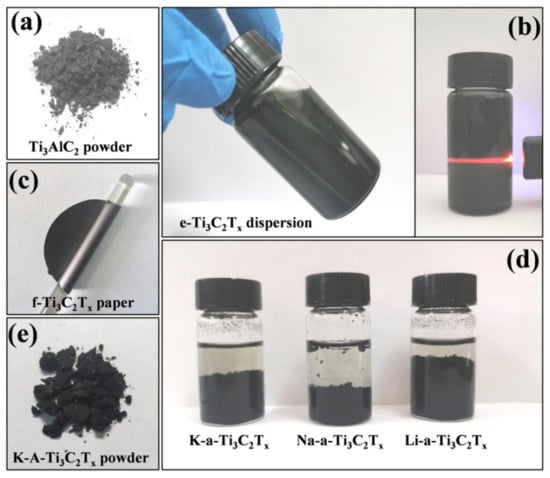
Figure 2.
Appearance of the samples: (a) Ti3AlC2 powder, (b) e-Ti3C2Tx, (c) f- Ti3C2Tx paper, (d) K-a-Ti3C2Tx, Na-a-Ti3C2Tx and Li-a-Ti3C2Tx, and (e) K-A-Ti3C2Tx powder.
Figure 3a–h shows the XRD patterns of Ti3AlC2, f-Ti3C2Tx, K-a-Ti3C2Tx, Na-a-Ti3C2Tx, Li-a-Ti3C2Tx, K-A-Ti3C2Tx, Na-A-Ti3C2Tx, and Li-A-Ti3C2Tx, respectively. The right side of Figure 3 presents the enlarged XRD pattern with diffraction angle of 5°–10°. The characteristic peaks of Ti3AlC2 completely disappear after etching (Figure 3), which indicates that Ti3AlC2 is completely converted into Ti3C2Tx. For f-Ti3C2Tx, only one (002) characteristic peak located at 6.21° is observed, and calculated dc/2, considered to be half of the c lattice parameter, is 14.2 Å. However, except f-Ti3C2Tx, all other treated samples exhibit two characteristic diffraction peaks at 34.7° (101) and 61.3° (110). This finding indicates that the f-Ti3C2Tx film flakes are highly ordered parallel to the substrate. In addition, the (002) peaks of the samples obtained through alkalization with KOH, NaOH, and LiOH appear at 6.66°, 6.36°, and 5.79°, respectively. Their corresponding dc/2 values are 13.2, 13.8, and 15.2 Å, respectively, which are larger than those of Ti3AlC2. K-a-Ti3C2Tx has smaller dc/2 than Na-a-Ti3C2Tx and Li-a-Ti3C2Tx. This trend is inconsistent with the increase in ion radii reported in the literature [30]; however, it is positively correlated with the trend of hydrated ion radii [31]. Therefore, we speculated that the water molecules can co-embed with alkali metal ions during alkalization. The (002) peaks of K-A-Ti3C2Tx, Na-A-Ti3C2Tx, and Li-A-Ti3C2Tx shifted towards right. The calculated dc/2 values of K-A-Ti3C2Tx, Na-A-Ti3C2Tx, and Li-A-Ti3C2Tx are 12.2, 13.1, and 13.5 Å, respectively. The layer spacing of the samples obviously decreased after annealing. To some extent, this phenomenon may occur as annealing can lead to the purification of sample surface ionic groups and crystal water. Simultaneously, due to the oxidation of Ti3C2Tx, a small amount of the TiO2 phase is inevitably found in the annealed samples [32].
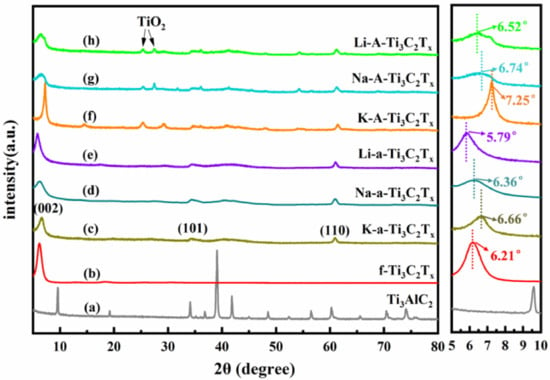
Figure 3.
XRD patterns of (a) Ti3AlC2, (b) f-Ti3C2Tx, (c) K-a-Ti3C2Tx, (d) Na-a-Ti3C2Tx, (e) Li-a-Ti3C2Tx, (f) K-A-Ti3C2Tx, (g) Na-A-Ti3C2Tx, and (h) Li-A-Ti3C2Tx. The right side of the figure presents the enlarged XRD pattern with diffraction angle of 5°–10°.
To confirm the aforementioned speculation, the XPS spectra of f-Ti3C2Tx and K-a-Ti3C2Tx were analyzed. The XPS results are shown in Figure 4. The complete XPS spectrum (Figure 4a) suggests the presence of C, Ti, O, F, and a small amount of Cl elements in f-Ti3C2Tx. In K-a-Ti3C2Tx obtained through KOH alkalization, the strength of F and Cl elements is weaker than that in f-Ti3C2Tx. An extra element (K) is observed in K-a-Ti3C2Tx after KOH alkalization. Therefore, the content of –F and –Cl ions on the Ti3C2Tx surface can be effectively reduced through alkalization. In addition, in K-A-Ti3C2Tx (Figure 4a), the Cl element almost disappears after annealing, and the intensity of element F considerably decreases. The annealing process can be further used to reduce the content of –F and –Cl ions on the Ti3C2Tx surface.

Figure 4.
XPS results of f-Ti3C2Tx, K-a-Ti3C2Tx, and K-A-Ti3C2Tx: (a) full spectrum, (b) C 1s spectra, (c) O 1s spectra, and (d) Ti 2p spectra.
The high-resolution XPS spectra of C 1s (Figure 4b) presents the peaks for surface Ti–C (281.8 eV), Ti–C–O (282.4 eV), C–C (284.8 eV), C–O–C (286.4 eV), and O–C=O (288.3 eV). Three peaks of the O 1s XPS spectra are attributed to surface Ti–O (529.8 eV), Ti–O–H (531.6 eV), and C–O (532.4 eV) (Figure 4c). Six peaks of Ti–C 2p3/2 (454.7 eV), Ti(II) 2p2/3 (555.8 eV), Ti–O 2p2/3 (558.3 eV), Ti–C 2p1/2 (460.8 eV), Ti(II) 2p1/2 (461.8 eV), and Ti-O 2p1/2 (464.0 eV) appear in the Ti 2p XPS spectra (Figure 4d). The results of C 1s, O 1s, and Ti 2p indicate that the peak intensities of C–O–C, O–C=O, and Ti–O 2p2/3 enhance after alkalization. The vacancy created by the reduction in –F and –Cl groups during alkalization is occupied by the –OH or =O group. After annealing, the peak strength of Ti–O and Ti–O 2p2/3 increases. The small amount of exposed Ti, obtained from the removal of surface groups such as –F and –Cl during alkalization and annealing, is oxidized, which is consistent with the XRD results presented in Figure 3f. The peak strength of Ti–C decreased, indicating that the oxidation of Ti leads to the fracture of a part of the Ti–C bond. The Ti–O–H bond disappears after annealing and is replaced with the =O bond. This phenomenon has positive practical significance for improving the performance of Ti3C2Tx [33,34].
The morphology and microstructure of Ti3AlC2, e-Ti3C2Tx, f-Ti3C2Tx, K-a-Ti3C2Tx, Na-a-Ti3C2Tx, Li-a-Ti3C2Tx, K-A-Ti3C2Tx, Na-A-Ti3C2Tx, and Li-A-Ti3C2Tx were observed through SEM (Figure 5). Ti3AlC2 exhibits the typical lamellar structure of MAX phase ceramic materials (Figure 5a). The warping edges of e-Ti3C2Tx nanosheets can be observed (Figure 5b). These results show that the multilayer Ti3C2Tx becomes completely stripped after dispersion stripping, and the obtained e-Ti3C2Tx nanosheets exhibit few layers or a monolayer with flexibility. Compared with that of e-Ti3C2Tx, the cross-sectional view of f-Ti3C2Tx paper shows a well-arranged, layered, and extremely coherent structure (Figure 5c). This finding can further verify the XRD results shown in Figure 3b. However, K-a-Ti3C2Tx with the 3D porous structure and fold shape was prepared through alkaline-induced flocculation by using KOH (Figure 5d). The 3D porous structure comprises crumpled, open, interpenetrating, Ti3C2Tx nanosheets, which form many irregular large pores with diameters of 100−500 nm. Compared with KaOH utilisation, when NaOH or LiOH (Figure 5d,e) was used for alkalinisation, no obvious differences were observed in the final 3D porous structure. After annealing, the 3D porous structures of the samples were not damaged (Figure 5g–i). However, a small amount of particles attached to the M’-A-Ti3C2Tx flakes, M’ represents K, Na, and Li. The XRD results (Figure 3f–h) reveal that these small particles are TiO2.

Figure 5.
SEM images of: (a) Ti3AlC2, (b) e-Ti3C2Tx, (c) f-Ti3C2Tx, (d) K-a-Ti3C2Tx, (e) Na-a-Ti3C2Tx, (f) Li-a-Ti3C2Tx, (g) K-A-Ti3C2Tx, (h) Na-A-Ti3C2Tx, and (i) Li-A-Ti3C2Tx.
The TEM images of f-Ti3C2Tx, K-a-Ti3C2Tx, and K-A-Ti3C2Tx are shown in Figure 6a–c. The thin e-Ti3C2Tx flake has a graphene-like structure (Figure 6a). After alkalization, the Ti3C2Tx flakes curls and folds into the 3D porous structure (Figure 6b). This finding is consistent with the SEM results shown in Figure 5d. The high-resolution TEM (HRTEM) results reveal that the lattice spacing of the sample after alkalization decreases from 1.41 to 1.31 nm. After annealing, the lattice spacing further decreases to approximately 1.22 nm, which is consistent with the XRD results.
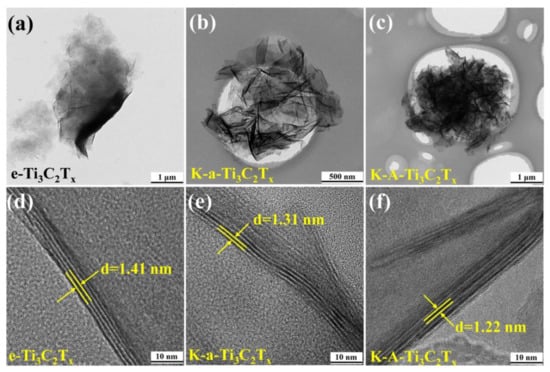
Figure 6.
TEM images of: (a) e-Ti3C2Tx, (b) K-a-Ti3C2Tx, (c) K-A-Ti3C2Tx and HRTEM images of: (d) e-Ti3C2Tx, (e) K-a-Ti3C2Tx, and (f) K-A-Ti3C2Tx.
The N2 adsorption–desorption isotherms are shown in Figure 7. The curves of several samples show obvious H3 hysteresis loops for the relative pressure of 0.5–1, which indicates that the layered material aggregates have mesopores and macropores. The specific surface areas of f-Ti3C2Tx, Li-a-Ti3C2Tx, Na-a-Ti3C2Tx, K-a-Ti3C2Tx and K-A-Ti3C2Tx are 2.21, 10.51, 19.67, 30.73 and 33.06 m2 g−1, respectively. The specific surface areas of the samples before the alkalization–flocculation treatment are small as a result of the stacking and agglomeration of nanosheets. The specific surface areas considerably increased after the alkalization–flocculation treatment, whereas after annealing treatment, the surface area only slightly increased. The increase in the specific surface area considerably affects electrochemical performance.
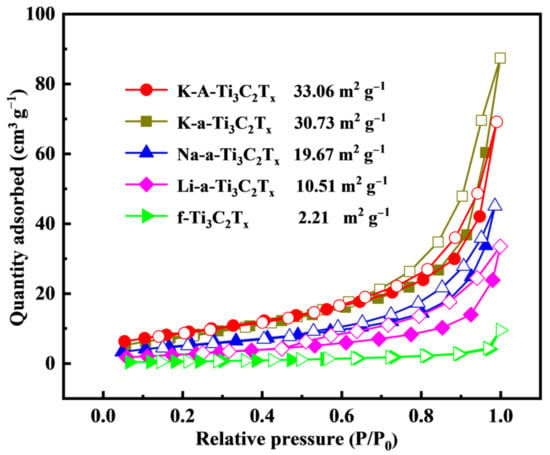
Figure 7.
N2 adsorption–desorption isotherms of f-Ti3C2Tx, K-a-Ti3C2Tx, Na-a-Ti3C2Tx, Li-a-Ti3C2Tx, and K-A-Ti3C2Tx.
The electrochemical performance of the samples was tested in the three-electrode system. Figure 8a shows the CV curves of all the samples at a scan rate of 10 mV s−1. After alkalization, the CV curve area of the sample increases. The area further increases after annealing. The specific capacitance of the material is proportional to the area under the CV curve. The capacitance of the 3D porous material obtained through alkalization and annealing increases considerably. The CV curves of f-Ti3C2Tx and a-Ti3C2Tx are nearly rectangular; however, a certain degree of distortion exists in the shape, which indicates that the double-layer charge and discharge are accompanied by Faraday redox processes in the sulfuric acid electrolyte. The bonding/debonding behavior can be observed between hydrated hydrogen and terminal oxygen for the Ti3C2Tx electrode. This behavior changes the valence state of Ti and generates a pseudocapacitance [35]. After annealing, the distortion degree of the CV curve of the sample aggravates, and a pair of redox peaks can be observed, which is attributed to the appearance of TiO2.
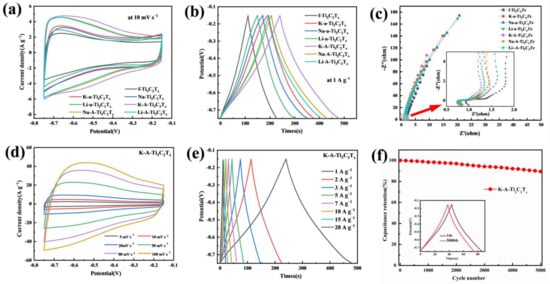
Figure 8.
(a) CV curves of the Ti3C2Tx electrodes at the scan rate of 10 mV s−1, (b) GCD profiles of the Ti3C2Tx electrodes at the scan rate of 1 A g−1, (c) Electrochemical impedance spectroscopy data of the Ti3C2Tx electrodes, (d) CV curves of the K-A-Ti3C2Tx electrode at the scan rates of 10–100 mV s−1, (e) GCD profiles of the K-A-Ti3C2Tx electrode at the scan rates of 1–20 A g−1, and (f) Cyclic stability of the K-A-Ti3C2Tx electrode at a current density of 5 A g−1.
The GCD discharge time is usually used to represent the electrode capacity to store charges at the same current density. Figure 8b shows the GCD curve of all the samples at a current density of 1 A g−1. According to the GCD curves (Figure 8b), K-A-Ti3C2Tx has the longest discharge time, indicating that it has the highest specific capacity. The EIS test was performed on the electrode material. The measured Nyquist curve is shown in Figure 8c. The Nyquist curve mainly includes two parts: the high- and low-frequency areas. The enlarged image of the high-frequency area (Figure 8c) shows that Ti3C2Tx has a smaller semicircle; thus, the charge transfer resistance is small, which contributes to high magnification performance. The curve in the low-frequency region appears as a straight line. Its slope corresponds to the capacitance characteristics of the material, which is related to ion diffusion/transmission and Warburg impedance. The higher is the slope value of the curve, the lower is the diffusion resistance [36]. The straight lines of all the samples are almost perpendicular to the X axis, indicating good capacitance characteristics. The slope of K-A-Ti3C2Tx is the highest, indicating that it has better ion mobility and lower diffusion resistance than the other samples.
Figure 8d,e shows the CV and GCD curves of K-A-Ti3C2Tx at different scan rates and current densities, respectively. When the scan rate increases, the shape of the CV curve shows a certain degree of distortion, which is related to the low diffusion of electrolyte ions at high scan rates [37]. The charging and discharging times of the GVD curve are equal, and the shape of the curve is close to an isosceles triangle, indicating that the material exhibits high Coulomb efficiency and good capacitance characteristics. The cycle stability test was performed on K-A-Ti3C2Tx. After 5000 charge–discharge cycles at the current density of 5 A g−1, the specific capacity remained 89% of the initial value. Figure 8f presents the GCD curve for the 1st and 5000th cycles. The shape of the GCD curve for the sample of K-A-Ti3C2Tx remains excellent, indicating that the material exhibits good reversibility and cycle stability.
Figure 9 shows the specific capacitance of Ti3C2Tx electrodes at the scan rates of 1–20 A g−1. At the current density of 1 A g−1, the mass specific capacities of f-Ti3C2Tx, K-a-Ti3C2Tx, Na-a-Ti3C2Tx, Li-a-Ti3C2Tx, K-A-Ti3C2Tx, Na-A-Ti3C2Tx, and Li-A- Ti3C2Tx are 228.2, 300.2, 285.7, 250.8, 400.7, 343.3, and 326.7, respectively. The electrochemical performance of K-A-Ti3C2Tx improved substantially. The subsequent annealing treatment further reduced the content of unfavorable surface functional groups, and electrochemical performance was improved. This result is higher than previous report on Ti3C2Tx-based materials, the detailed data are listed in Table 1. The specific capacities of the Ti3C2Tx samples obtained through alkaline flocculation and annealing at different current densities are excellent. With its excellent 3D porous structure, perfect surface cleanliness, and large layer spacing, K-A-Ti3C2Tx shows outstanding electrochemical performance.
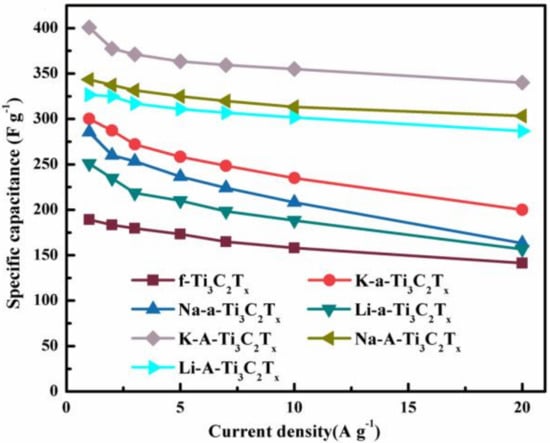
Figure 9.
Specific capacitance of the Ti3C2Tx electrode at the scan rates of 1–20 A g−1.

Table 1.
Comparison of capacitance for the Ti3C2Tx-based electrodes materials.
4. Conclusions
In summary, this study confirmed that the addition of alkali to Ti3C2Tx colloids can make nanosheets to flocculate and deposit. Alkalization and flocculation were conducted simultaneously, and the 3D porous structure was constructed through simple and effective means. The pore diameter of macropores can reach several hundred nanometres, which considerably increases the specific surface area of the material. Alkalization and annealing effectively reduced the adverse surface groups of the material and exposed more active sites, which is beneficial for improving the electrochemical performance of the material. The sample treated with KOH exhibits a higher specific surface area (33.06 m2 g−1) and better electrochemical performance than that treated with NaOH and LiOH. In the three-electrode system with 1 M H2SO4 as the electrolyte, K-A-Ti3C2Tx shows a high specific capacity of approximately 400.7 F g−1 at the current density of 1 A g−1 and attains 89% cycle stability after 5000 charge–discharge cycles. A simple and effective strategy can promote the practical application of Ti3C2Tx supercapacitor electrodes.
Author Contributions
Methodology, software, investigation, and data curation, J.T. and W.C.; supervision, P.C. and W.C.; formal analysis, Y.X. and Y.A.; validation and resources, N.Y.; All the authors discussed the data and wrote the manuscript. All authors have read and agreed to the published version of the manuscript.
Funding
This work was supported by the National Natural Science Foundation of China (No. 51864034, 51471083, 51364036) and the National Key R&D Program of China (No. SQ2018YFC200227).
Institutional Review Board Statement
Not applicable.
Informed Consent Statement
Not applicable.
Data Availability Statement
Data are contained within the article and can be requested from the corresponding author.
Conflicts of Interest
The authors declare no conflict of interest.
References
- Dehghani-Sanij, A.R.; Tharumalingam, E.; Dusseault, M.B.; Fraser, R. Study of energy storage systems and environmental challenges of batteries. Renew. Sust. Energy. Rev. 2019, 104, 192–208. [Google Scholar] [CrossRef]
- Koohi-Fayegh, S.; Rosen, M.A. A review of energy storage types, applications and recent developments. J. Energy Storage 2020, 27, 101047. [Google Scholar] [CrossRef]
- Lin, Z.; Goikolea, E.; Balducci, A.; Naoi, K.; Taberna, P.L.; Salanne, M.; Yushin, G.; Simon, P. Materials for supercapacitors: When Li-ion battery power is not enough. Mater. Today 2018, 21, 419–436. [Google Scholar] [CrossRef] [Green Version]
- Winter, M.; Brodd, R.J. What are batteries, fuel cells, and supercapacitors? Chem. Rev. 2004, 104, 4245–4270. [Google Scholar] [CrossRef] [PubMed] [Green Version]
- Sharma, K.; Arora, A.; Tripathi, S.K. Review of supercapacitors: Materials and devices. J. Energy Storage 2019, 21, 801–825. [Google Scholar]
- Afif, A.; Rahman, S.M.; Azad, A.T.; Zaini, J.; Islan, M.A.; Azad, A.K. Advanced materials and technologies for hybrid supercapacitors for energy storage—A review. J. Energy Storage 2019, 25, 100852. [Google Scholar] [CrossRef]
- Tang, Q.; Zhou, Z. Graphene-analogous low-dimensional materials. Prog. Mater. Sci. 2013, 58, 1244–1315. [Google Scholar] [CrossRef]
- Han, Y.; Ge, Y.; Chao, Y.; Wang, C.; Wallace, G.G. Recent progress in 2D materials for flexible supercapacitors. J. Energy Chem. 2018, 27, 57–72. [Google Scholar] [CrossRef] [Green Version]
- Tsang, C.; Huang, H.; Xuan, J.; Wang, H.; Leung, D. Graphene materials in green energy applications: Recent development and future perspective. Renew. Sust. Energy. Rev. 2020, 120, 109656. [Google Scholar] [CrossRef]
- Maduraiveeran, G.; Sasidharan, M.; Jin, W. Earth-abundant transition metal and metal oxide nanomaterials: Synthesis and electrochemical applications. Prog. Mater. Sci. 2019, 106, 100574. [Google Scholar] [CrossRef]
- Wen, Y.Y.; Rufford, T.E.; Chen, X.Z.; Li, N.; Lyu, M.Q.; Dai, L.M.; Wang, L.Z. Nitrogen-doped Ti3C2Tx MXene electrodes for high-performance supercapacitors. Nano Energy 2017, 38, 368–376. [Google Scholar] [CrossRef]
- Zhang, C.J.; Nicolosi, V. Graphene and MXene-based transparent conductive electrodes and supercapacitors. Energy Storage Mater. 2019, 16, 102–125. [Google Scholar] [CrossRef]
- Naguib, M.; Kurtoglu, M.; Presser, V.; Lu, J.; Niu, J.; Heon, M.; Hultman, L.; Gogotsi, Y.; Barsoum, M.W. Two-Dimensional Nanocrystals Produced by Exfoliation of Ti3AlC2. Adv. Mater. 2011, 23, 4248–4253. [Google Scholar] [CrossRef] [PubMed] [Green Version]
- Naguib, M.; Mochalin, V.N.; Barsoum, M.W.; Gogotsi, Y. 25th Anniversary Article: MXenes: A New Family of Two-Dimensional Materials. Adv. Mater. 2014, 26, 992–1005. [Google Scholar] [CrossRef] [PubMed]
- Zhang, X.; Zhang, Z.; Zhou, Z. MXene-based materials for electrochemical energy storage. J. Energy Chem. 2018, 27, 73–85. [Google Scholar] [CrossRef] [Green Version]
- Venkateshalu, S.; Grace, A.N. MXenes-A new class of 2D layered materials: Synthesis, properties, applications as supercapacitor electrode and beyond. Appl. Mater. Today 2020, 18, 100509. [Google Scholar] [CrossRef]
- Xie, Y.; Naguib, M.; Mochalin, V.N.; Barsoum, M.W.; Gogotsi, Y.; Yu, X.; Nam, K.; Yang, X.; Kolesnikov, A.I.; Kent, P.R.C. Role of surface structure on Li-ion energy storage capacity of two-dimensional transition-metal carbides. J. Am. Chem. Soc. 2014, 136, 6385–6394. [Google Scholar] [CrossRef] [PubMed]
- Li, L.; Zhang, M.; Zhang, X.; Zhang, Z. New Ti3C2 aerogel as promising negative electrode materials for asymmetric supercapacitors. J. Power Sources 2017, 364, 234–241. [Google Scholar] [CrossRef]
- Shi, L.; Lin, S.; Li, L.; Wu, W.; Wu, L.; Gao, H.; Zhang, X. Ti3C2Tx-foam as free-standing electrode for supercapacitor with improved electrochemical performance. Ceram. Int. 2018, 44, 13901–13907. [Google Scholar] [CrossRef]
- Zhang, X.; Liu, Y.; Dong, S.; Yang, J.; Liu, X. Flexible electrode based on multi-scaled MXene (Ti3C2Tx) for supercapacitors. J. Alloys Compd. 2019, 790, 517–523. [Google Scholar] [CrossRef]
- Natu, V.; Clites, M.; Pomerantseva, E.; Barsoum, M.W. Mesoporous MXene powders synthesized by acid induced crumpling and their use as Na-ion battery anodes. Mater. Res. Lett. 2018, 6, 230–235. [Google Scholar] [CrossRef] [Green Version]
- Natu, V.; Sokol, M.; Verger, L.; Barsoum, M.W. Effect of edge charges on stability and aggregation of Ti3C2Tx MXene colloidal suspensions. J. Phys. Chem. C 2018, 122, 27745–27753. [Google Scholar] [CrossRef]
- Peng, Q.; Guo, J.; Zhang, Q.; Xiang, J.; Liu, B.; Zhou, A.; Liu, R.; Tian, Y. Unique lead adsorption behavior of activated hydroxyl group in two-dimensional titanium carbide. J. Am. Chem. Soc. 2014, 136, 4113–4116. [Google Scholar] [CrossRef] [PubMed]
- Zhang, X.; Liu, Y.; Dong, S.; Yang, J.; Liu, X. Surface modified MXene film as flexible electrode with ultrahigh volumetric capacitance. Electrochim. Acta 2019, 294, 233–239. [Google Scholar] [CrossRef]
- Lu, M.; Li, H.; Han, W.; Chen, J.; Shi, W.; Wang, J.; Meng, X.; Qi, J.; Li, H.; Zhang, B.; et al. 2D titanium carbide (MXene) electrodes with lower-F surface for high performance lithium-ion batteries. J. Energy Chem. 2019, 31, 148–153. [Google Scholar] [CrossRef]
- Dall’Agnese, Y.; Lukatskaya, M.R.; Cook, K.M.; Taberna, P.; Gogotsi, Y.; Simon, P. High capacitance of surface-modified 2D titanium carbide in acidic electrolyte. Electrochem. Commun. 2014, 48, 118–122. [Google Scholar] [CrossRef] [Green Version]
- Chen, W.; Tang, J.; Shi, X.; Ye, N.; Yue, Z.; Lin, X. Synthesis and formation mechanism of high-purity Ti3AlC2 powders by microwave sintering. Int. J. Appl. Ceram. Technol. 2019, 17, 778–789. [Google Scholar] [CrossRef]
- Zhang, T.; Pan, L.; Tang, H.; Du, F.; Guo, Y.; Qiu, T.; Yang, J. Synthesis of two-dimensional Ti3C2Tx MXene using HCl+LiF etchant: Enhanced exfoliation and delamination. J. Alloys Compd. 2017, 695, 818–826. [Google Scholar] [CrossRef]
- Yan, J.; Ren, C.E.; Maleski, K.; Hatter, C.B.; Anasori, B.; Urbankowski, P.; Sarycheva, A.; Gogotsi, Y. Flexible MXene/graphene films for ultrafast supercapacitors with outstanding volumetric capacitance. Adv. Funct. Mater. 2017, 27, 1701264. [Google Scholar] [CrossRef]
- Ghidiu, M.; Halim, J.; Kota, S.; Bish, D.; Barsoum, M.W. Ion-exchange and cation solvation reactions in Ti3C2 MXene. Chem. Mater. 2016, 28, 3507–3514. [Google Scholar] [CrossRef] [Green Version]
- Clites, M.; Pomerantseva, E. Bilayered vanadium oxides by chemical pre-intercalation of alkali and alkali-earth ions as battery electrodes. Energy Storage Mater. 2018, 11, 30–37. [Google Scholar] [CrossRef]
- Li, J.; Yuan, X.; Lin, C.; Yang, Y.; Xu, L.; Du, X.; Xie, J.; Lin, J.; Sun, J. Achieving high pseudocapacitance of 2D titanium carbide (MXene) by cation intercalation and surface modification. Adv. Energy Mater. 2017, 7, 1602725. [Google Scholar] [CrossRef]
- Xie, Y.; Kent, P.R.C. Hybrid density functional study of structural and electronic properties of functionalized Tin+1Xn(X=C, N) monolayers. Phys. Rev. B 2013, 87, 235441. [Google Scholar] [CrossRef] [Green Version]
- Tang, Q.; Zhou, Z.; Shen, P. Are MXenes promising anode materials for Li ion batteries? Computational studies on electronic properties and Li storage capability of Ti3C2 and Ti3C2X2 (X = F, OH) monolayer. J. Am. Chem. Soc. 2012, 134, 16909–16916. [Google Scholar] [CrossRef]
- Syamsai, R.; Kollu, P.; Jeong, S.K.; Grace, A.N. Synthesis and properties of 2D-titanium carbide MXene sheets towards electrochemical energy storage applications. Ceram. Int. 2017, 43, 13119–13126. [Google Scholar] [CrossRef]
- Zhang, J.; Zhao, X. On the configuration of supercapacitors for maximizing electrochemical performance. ChemSusChem 2012, 5, 818–841. [Google Scholar] [CrossRef]
- Wu, W.; Lin, S.; Chen, T.; Li, L.; Pan, Y.; Zhang, M.; Wu, L.; Gao, H.; Zhang, X. Performance evaluation of asymmetric supercapacitor based on Ti3C2Tx-paper. J. Alloys Compd. 2017, 729, 1165–1171. [Google Scholar] [CrossRef]
- Michael, G.; Maria, R.L.; Zhao, M.Q.; Gogotsi, Y.; Barsoum, M.W. Conductive two-dimensional titanium carbide ‘clay’ with high volumetric capacitance. Nature 2014, 516, 78–81. [Google Scholar]
- Lukatskaya, M.R.; Kota, S.; Lin, Z.F.; Zhao, M.Q.; Shpigel, N.; Levi, M.D.; Halim, J.; Taberna, P.L.; Barsoum, M.W.; Simon, P.; et al. Ultra-high-rate pseudocapacitive energy storage in two-dimensional transition metal carbides. Nat. Energy. 2017, 2, 17105–17111. [Google Scholar] [CrossRef]
- Yang, Q.Y.; Xu, Z.; Fang, B.; Huang, T.Q.; Cai, S.Y.; Chen, H.; Liu, Y.J.; Gopalsamy, K.; Gao, W.W.; Gao, C. MXene/graphene hybrid fibers for high performance flexible supercapacitors. J. Mater. Chem. A 2017, 5, 22113–22119. [Google Scholar] [CrossRef]
Publisher’s Note: MDPI stays neutral with regard to jurisdictional claims in published maps and institutional affiliations. |
© 2022 by the authors. Licensee MDPI, Basel, Switzerland. This article is an open access article distributed under the terms and conditions of the Creative Commons Attribution (CC BY) license (https://creativecommons.org/licenses/by/4.0/).